| Introduction | Forest Types | |
| Forest Characteristics | Management | |
| Forest Contributions | Special Considerations | |
| The Forest Plan | Assistance |
![]()
FOREST MANAGEMENT GUIDELINES FOR MICHIGAN |
| Introduction | Forest Types | |
| Forest Characteristics | Management | |
| Forest Contributions | Special Considerations | |
| The Forest Plan | Assistance |
![]()
FOREST MANAGEMENT GUIDELINES FOR MICHIGAN |
Silvicultural Systems
Silviculture is the art and science of tending and regenerating forest vegetation. A silvicultural system is a program of treatments that are prescribed to meet the forest owner's objectives through the life of a forest. The premise underlying any silvicultural system is long‑range sustainability, both of the forest itself and the production of goods and services from it. The silvicultural prescriptions that are part of any system may include harvesting or other treatments to promote tree growth and quality, alter species composition, reduce competition, create a certain stand structure or habitat, or regenerate a new stand, and they are specific to a particular stand of trees. Prescriptions may also recommend conversion of an existing stand to a different timber or vegetation type, or they may recommend that no treatments be made.
The starting point for developing silvicultural prescriptions is the forest owner objectives, which can include timber sales, wildlife habitat, visual quality or recreational considerations, high biodiversity, protection of water, minimizing pest or disease damage, or production of forest commodities like fruits, nuts, greenery, or mushrooms. A professional forester can help refine these objectives by taking into account the ecological characteristics of the stand and the site, any social or legal constraints that may exist (e.g., Best Management Practices for water quality protection or pesticide use regulations), and monetary factors, such as the need to generate income or budgetary limitations (Figure 10). Although prescriptions are developed on a stand-by-stand basis, a forest owner also must develop an understanding of how the stands in their ownership interact and how they relate to the surrounding landscape and other ownerships.
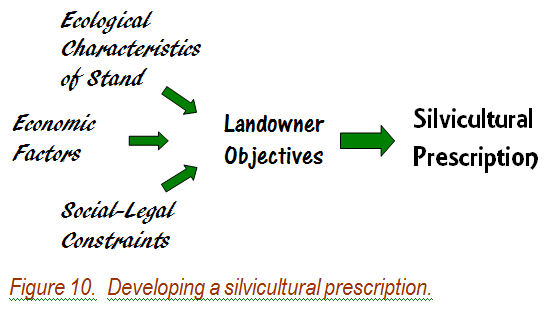
Once the objectives are set, the forester can work with the forest owner to implement them. If a timber harvest is planned, it is important to understand the roles of the forester and the logger. The forester is responsible for designing a forest plan, selecting the silvicultural system, planning for regeneration, determining the need for tending treatments, and arranging for the timber sale. The logger, on the other hand, is the person who does the harvesting of the trees in accord with the prescriptions developed by the forester and the forest owner.
Not all forests are managed. Not all timber harvests occur within the guidance a forest management plan. Timber harvest used to carry-out the objectives of a professionally guided plan promotes forest sustainability and increases the many values a forest owner might expect from their property. Decisions, or lack of them, have long-term impacts both ecologically and financially. Forest owners are encouraged to enlist the expertise of professional foresters when making decisions about their forests.
There are two basic silvicultural systems used in Michigan for management and regeneration of forest stands—even‑aged and uneven‑aged (also called all-aged). Under the even‑aged system, stands consist of overstory trees of the same, or nearly the same, age. The uneven‑aged system, by contrast, is applied in stands that contain trees of three or more different age classes. The choice depends on the ecology of the stand, its current structure, and the forest owner's objectives. In some cases these systems require little silvicultural input and then nature, so to speak, does all the work. In other cases more intensive or specialized techniques may be necessary to regenerate commercially or ecologically valuable species such as yellow birch, hemlock, jack pine, white cedar, and oak or to create and sustain ecologically diverse communities. These techniques may include site preparation to reduce competition and prepare a mineral soil seedbed, prescribed fire, application of herbicides, and seeding or planting.
Even-Aged Systems
The even‑aged system comprises three regeneration methods that represent a continuum of residual stand structures:
Clearcutting is the most common even‑aged regeneration method; it is most-often used to manage sun‑loving, shade intolerant species, although under the right circumstances it will successfully regenerate almost any type of forest community. In this method, an entire commercially mature stand is removed in one harvest. Aspen, because of its inherent ability to sprout from the roots of harvested trees, is the classic example of a species that regenerates well by clearcutting (Figure 11). Often small patches or a few scattered trees are left on the site for reasons of visual quality, wildlife habitat, mast (animal food) production, or biodiversity. Many applications of this method are enhanced by site preparation and planting or seeding. In some cases, advance regeneration of shade‑tolerant species (e.g., sugar maple, balsam fir, and white pine) may have become established under the trees that are harvested, presenting some options in determining the composition of the new stand.
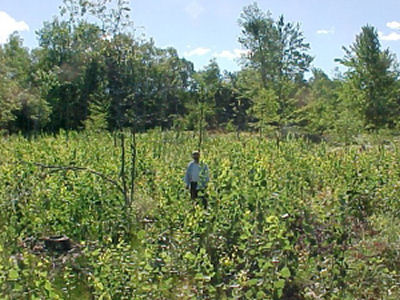
Figure 11. Aspen Regneration, First Season
Seedtree and shelterwood are also called retention systems because some trees are left behind following a harvest of mature timber.
In the seed tree method, nearly all of a commercially mature stand is removed in one cutting, except for a small number of trees that are left to provide seed for regenerating a new stand (Figure 12) and, sometimes, for other purposes as well. Seed trees may be scattered, in small groups, or in narrow strips. Seed trees do not provide enough shade to have an effect on regeneration. Seed trees are often light‑seeded, sun‑loving species whose seed is dispersed by the wind. Species that are more vulnerable to windthrow or wind breakage are not used as seed trees.
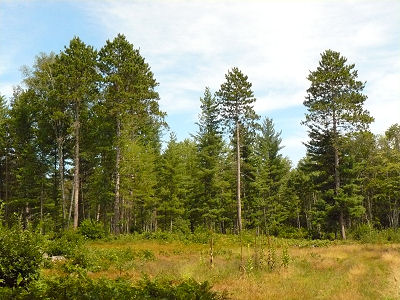
Figure 12. Red Pine Seed Tree Harvest
Shelterwood is the most complicated of the even‑aged systems and is an extension of the seed tree method. This method regenerates a new stand under the cover of a partial canopy called a shelterwood or overwood (Figure 13). The idea behind a shelterwood is that most tree species regenerate better in light to moderate shade, which provides a cooler, more moist environment, and the canopy of the overwood protects young seedlings from frost. This system is particularly useful for heavy‑seeded species (like oaks) or on harsh, droughty sites where regeneration following clearcutting can be problematic, but it can be successfully applied to almost any forest type. The shelterwood method involves two or more timber harvests: the first removes one-third to two-thirds of the mature trees, then when a young stand has regenerated and is well established the overwood is removed in another harvest. Sometimes part or all of the overwood is retained to create a more complex, two-aged stand structure and to grow really big trees. The new even-aged stand produced by this method can originate from seedlings, sprouts, or advance regeneration already established before the first harvest is done, depending on the species present and the ecology of the stand.
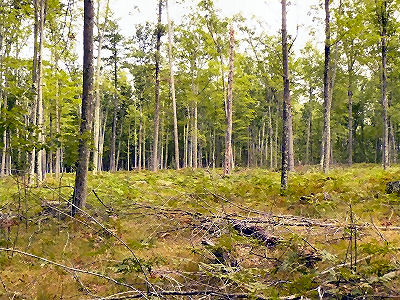
Figure 13. Oak Shelterwood.
Uneven-Aged Systems
The uneven‑aged system uses the selection method of harvesting, which favors tree species that thrive in moderate to moderately-heavy shade. It is the most complex system and should be implemented by a professional forester. There are two basic variations. Single tree selection removes scattered individual trees or small groups of two or three trees, creating small gaps in the overstory canopy that favor regeneration of shade tolerant tree species (Figure 14). Group selection, on the other hand, creates larger gaps by harvesting all trees in a one-quarter to one-half acre area, which can allow shade mid-tolerant species like yellow birch, basswood, or white pine to become established. Natural regeneration in the gaps may already be present as advance seedling regeneration or can occur from fresh seed fall. In northern hardwood management, however, advance regeneration in the form of saplings and small poles should be cut because their poor growth potential and common deformities.

Figure 14. Canopy gap and regeneration.
The successful application of this method depends on the condition and composition of the stand. It works best if a stand has at least three age or size (trunk diameter) classes or, better still, contains trees of all age classes, from seedlings to mature sawtimber. But the key to uneven-aged management is what is left behind in the residual stand after harvest (Figure 15). Trees to be cut should be individually selected from throughout all merchantable size classes so as to maintain or enhance the uneven-aged structure. It is also important not to cut too heavily in the largest diameter classes at any one time. If these principles are carefully followed, harvests can occur within the stand at regular time intervals of 10 to 15 years, called cutting cycles. The beauty of this method is that high-quality saw and veneer logs can be periodically harvested and generate income, yet the forest is retained. The selection system is the preferred management method for high quality northern hardwoods, where sugar maple is the major species, but it also works well in spruce-fir stands.
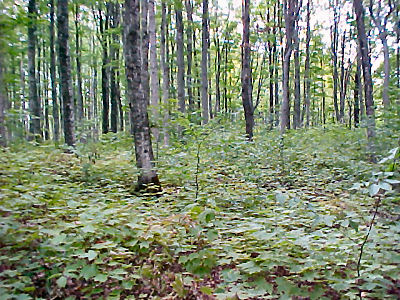
Figure 15. Post-harvest northern hardwoods.
Selection of individual trees in a stand for retention or harvest is based on the species, quality, biodiversity concerns, wildlife habitat or mast production, and diameter class distribution. Selection system harvesting should concentrate on age classes or tree diameter ranges that are too dense for optimum growth and on trees that will not be in good condition at the end of the cutting cycle in 10‑15 years. Trees marked for harvest should, by their removal, allow better quality, more vigorous trees to grow and use their growing space. The goal is to leave a distribution or mix of tree sizes that maintains the stand in an uneven‑aged condition. Usually adequate regeneration occurs under this system, but spot scarification (exposing mineral soil) or planting can be used to increase species diversity or increase the regeneration of commercially valuable species.
The uneven-aged system works best in stands that already have many or at least three age or diameter classes. In many cases, stands of tree species that can be managed by the uneven-aged system were converted to an even‑aged structure through past cutting, fires, grazing, or other disturbances. Such stands can be managed using one of the even-aged systems. However, development of a diverse, uneven-aged structure can be fostered through careful thinning favoring potential crop and wildlife trees to increase diameter growth rates and development of advance regeneration, although this will still take many decades.
Intermediate Treatments
Several tending treatments (operations carried out during the life of a stand but before final timber harvest) may be prescribed in even‑aged silvicultural systems to accomplish certain objectives. In young stands, thinning of dense regeneration and release of desired species from unwanted plant competition are applied to give the best trees more growing space and reduce the time needed to grow crop trees to a desired size. However, these treatments are a cost to the forest owner and are not always performed, despite their silvicultural benefit and the greater value they give to the final crop.
On the other hand, commercial thinning (the removal and sale of merchantable trees) is beneficial in all respects, usually associated with uneven-aged silvicultural systems. In Michigan commercial thinning should be performed whenever stands of intermediate-age are too dense and enough marketable trees can be cut to make the operation profitable. Thinning to proper densities by removing poorer quality tree stems and non‑commercial timber species frees the best trees from competition and allows them to grow faster in diameter. Thinning can be performed in any forest type that grows in Michigan, although it is seldom done in aspen or jack pine stands.
Pruning is the removal of living and dead limbs from the main stem of potential high-value crop trees. A tree properly pruned by cutting branches flush with the stem will produce knot-free wood once the wound heals over. Pruning also produces a more visually pleasing forest, for some people, and improves safety and access. Pruning is a good investment when knot‑free logs bring a premium price; e.g., with white pine, red oak, black cherry, or black walnut.
Prescribed fire is a useful silvicultural tool that simulates a natural ecological process. When fire is used as a tending operation in established, intermediate-aged or mature stands, it can reduce accumulation of fuels to lessen the chance of a destructive wildfire, improve wildlife habitat, discourage unwanted shrub or tree species, increase plant and animal biodiversity, reduce certain insects and diseases, and stimulate regeneration of favored trees. In Michigan, this type of prescribed fire is used in management of red pine stands or in oak and pine-oak savannas. Prescribed fire can also be used following a harvest of mature timber - principally clearcutting - to consume heavy accumulations of slash (residue following a timber sale) and prepare the site for natural seeding or planting.
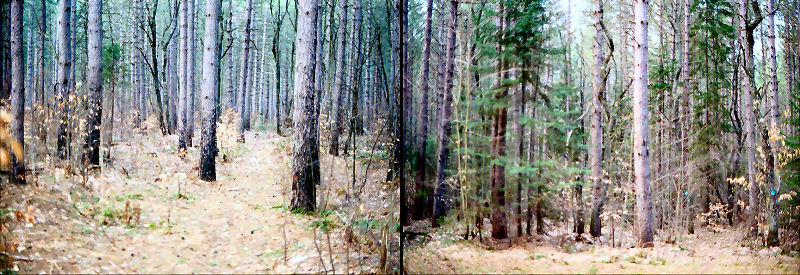
Prescribed fire in red pine (left) and control area (not burned) in same stand.
Related information
Harvest (Logging) Methods
Regeneration and Reforestation

This website is maintained by Bill Cook, Michigan State University Extension
Forest in the Upper Peninsula. Comments, questions,
and suggestions are gratefully accepted.
Last update of this page was 9 January, 2014
This site is hosted by School of Forest Resources and Environmental Science at Michigan Technological University.